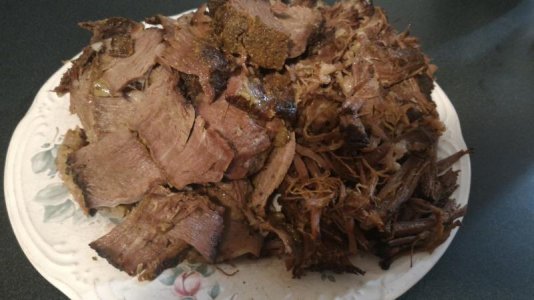RJ_Make - that you state that you find your cooks dry is something I've not run into in good kamado management of cooks. Let's take a look at your post and see if we can figure this out.
First, are you slicing the brisket and eating immediately or waiting. Brisket dries out quite quickly once sliced.
Second, are you trimming fat from the brisket flat before you cook it? If so, I suggest that you leave much more fat on your brisket flat before you put it on the grate. When you purchase a brisket, try and see how aggressively it was trimmed prior to being cryovaced for sale.
Third, I tend to cook my briskets fat cap up over a drip pan that rests on a heat deflector. I always use drip pans and heat deflectors when doing a low-n-slow cooks. I don't ever use a water pan when cooking in any of my kamados.
Fourth, to get a good deal of smoke on a cook, I put the cook in the freezer for an our before the cook goes on the cooking grate. Smoke condensation decreases as the surface tep of the cook increases during the cooking process.
Fifth, to get good smoke all during a cook, strategic placement of wood chunks is paramount. Now I heat soak my kamados for an hour or so at the cooking temp so that once a assemble everything for the cook, everything gets back to temp ASAP. I always do low-n-slows with a heat deflector, a drip pan, the cooking grate, and then the cook. Prior to heat soaking, I just pile all this stuff on the main grate. Then when I'm ready to cook, I'll assemble per the above. This is when I put on the smoke wood. I place the smoke wood in concentric circles around the fire. A priori, you really don't know how the fire will spread. So I put a fair amount in very close concentric circles. I nestle the smoke wood down in the lup level with the top of the lump. Work quickly as your heat deflector and cooking grate is cooling while you put smoke wood in your cooker.
Sixth, and this sounds counter intuitive, but I've never wrapped a single low-n-slow cook in over 20 years of kamado cooking until I pull the cook and then I wrap it for storage in my cooler. I've never had a dry cook. I also Generally don't pull a cook until it probes very tender at between 200-205° or so. If you like to wrap, might I suggest that you add some apple juice during the wrapping process? This might help with the dryness.
Seventh, I notice that you've used a digital temp controller. I don't, but that's a personal preference. What percentage of the time was the fan blowing? If it was blowing a big percentage of the time, this might be causing some of our dryness. What's happening is you're blowing moisture that would orally be staying inside the kamado out the top vent. Check your cook details for your blower. Just a thought.
Lastly, I know a good many folks who have great results with their Vision Kamados. So will you. We'll get this figured out for you. No big deal.




